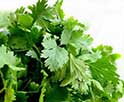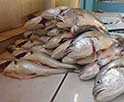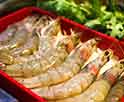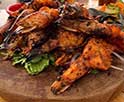Blood Cockle: Health Risks and Safe Consumption (Blood clam)
Is Eating Red Cockles Good for You? Nutrition Facts
Reading time : 1 minute,
Discovery Chepe Id-691-GAS
Published in
05-07-2025

Blood clams, known for their dark red hemolymph and strong ocean flavor, are a delicacy in several coastal cuisines. Particularly popular in Latin American and Southeast Asian countries, these shellfish have recently gained attention among adventurous food lovers in the United States.
What Are Blood Clams?
These clams belong to the genus Anadara and are often called -red blood clams- due to their unique red blood, which contains hemoglobin-unusual for mollusks. They are sometimes confused with "pata de mula," a Spanish name that is more common in regions like Mexico and Central America.
Habitat and Origin
Blood clams are typically found in warm coastal waters. They thrive in estuaries, muddy beaches, and mangrove areas, especially along the Pacific coasts of Mexico, Central America, Ecuador, and also in Southeast Asia. These environments, rich in nutrients but also in organic waste, contribute to the clam's distinct flavor and biological makeup.
Benefits of Eating Blood Clams
Rich in Nutrients: These clams are high in protein, iron, and omega-3 fatty acids, supporting muscle health and cardiovascular function.
Unique Flavor: Their briny, slightly metallic taste makes them a sought-after ingredient in ceviches and raw seafood dishes.
Tradition and Culture: Consuming blood clams is often tied to local traditions, especially in Pacific coastal cuisines. They are a staple in dishes like Ecuadorian ceviche de concha negra.

Red Cockle: Nutrition, Benefits, and What to Know
Health Risks and Concerns
While delicious, blood clams carry certain health risks due to their environment and physiology.
Possible Diseases:
Blood clams can harbor viruses and bacteria such as hepatitis A, norovirus, Vibrio vulnificus, and even typhoid. This is because they are filter feeders and can accumulate pathogens from contaminated waters.
Raw Consumption Danger:
In many traditional recipes, blood clams are consumed raw or lightly cooked, which increases the risk of transmitting harmful microorganisms. According to the U.S. FDA, raw shellfish is one of the most common sources of foodborne illness.

Environmental Contamination:
Since these clams are often harvested in low-oxygen and nutrient-heavy waters, they are more susceptible to being contaminated by human and industrial waste.
How to Eat Blood Clams Safely
Source Matters: Always buy blood clams from reputable seafood markets that follow U.S. import health standards.
Cook Thoroughly: The safest way to consume blood clams is to boil or grill them until the internal temperature reaches at least 145°F (63°C).
Avoid Raw Varieties: Especially for pregnant women, children, the elderly, and people with weakened immune systems.
Clean Well: If preparing at home, soak the clams in clean salted water for at least an hour to help purge sediment and debris.
Check Local Advisories: Some states may issue red tide or contamination warnings for shellfish. Always stay updated via resources like the NOAA's shellfish advisories: NOAA Shellfish Safety.
Blood clams, or "pata de mula," offer a unique culinary experience with high nutritional value and cultural significance. However, the potential health risks -especially when eaten raw- should not be ignored. For those willing to try them, proper sourcing and thorough cooking are essential to enjoy them safely.
Always prioritize safety over tradition when it comes to consuming exotic seafood delicacies.
See Also
Discovery Chepe
Most read...















